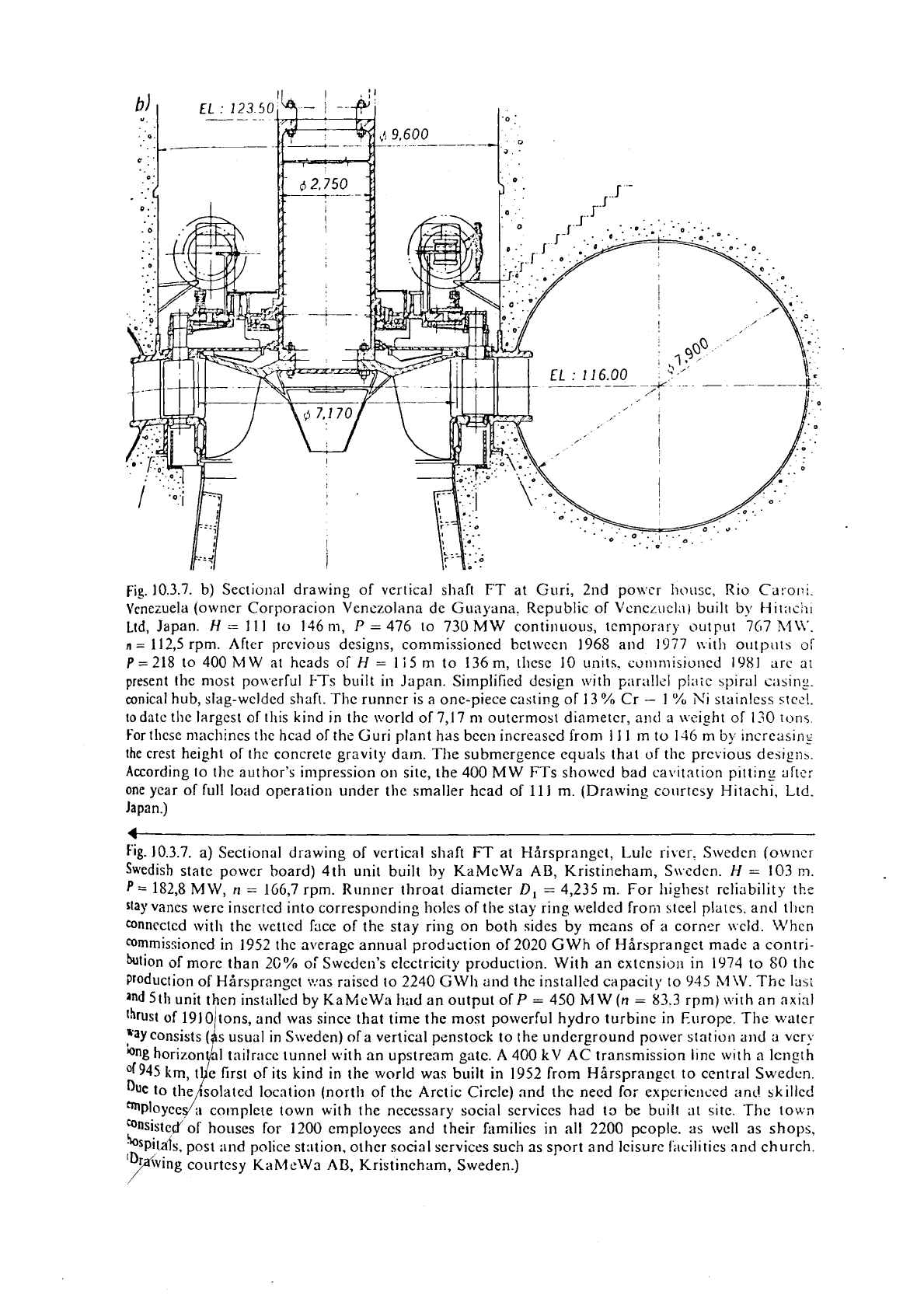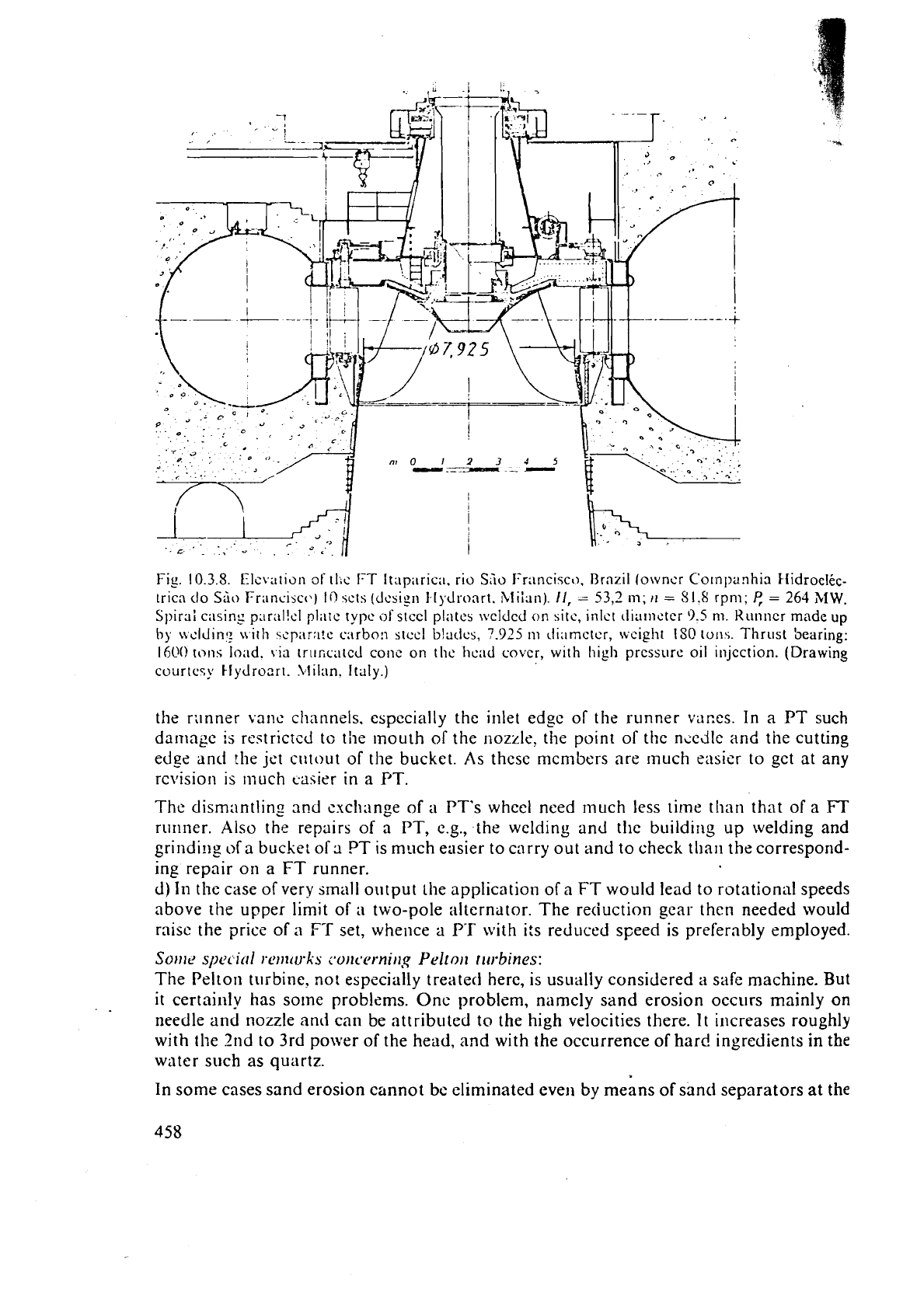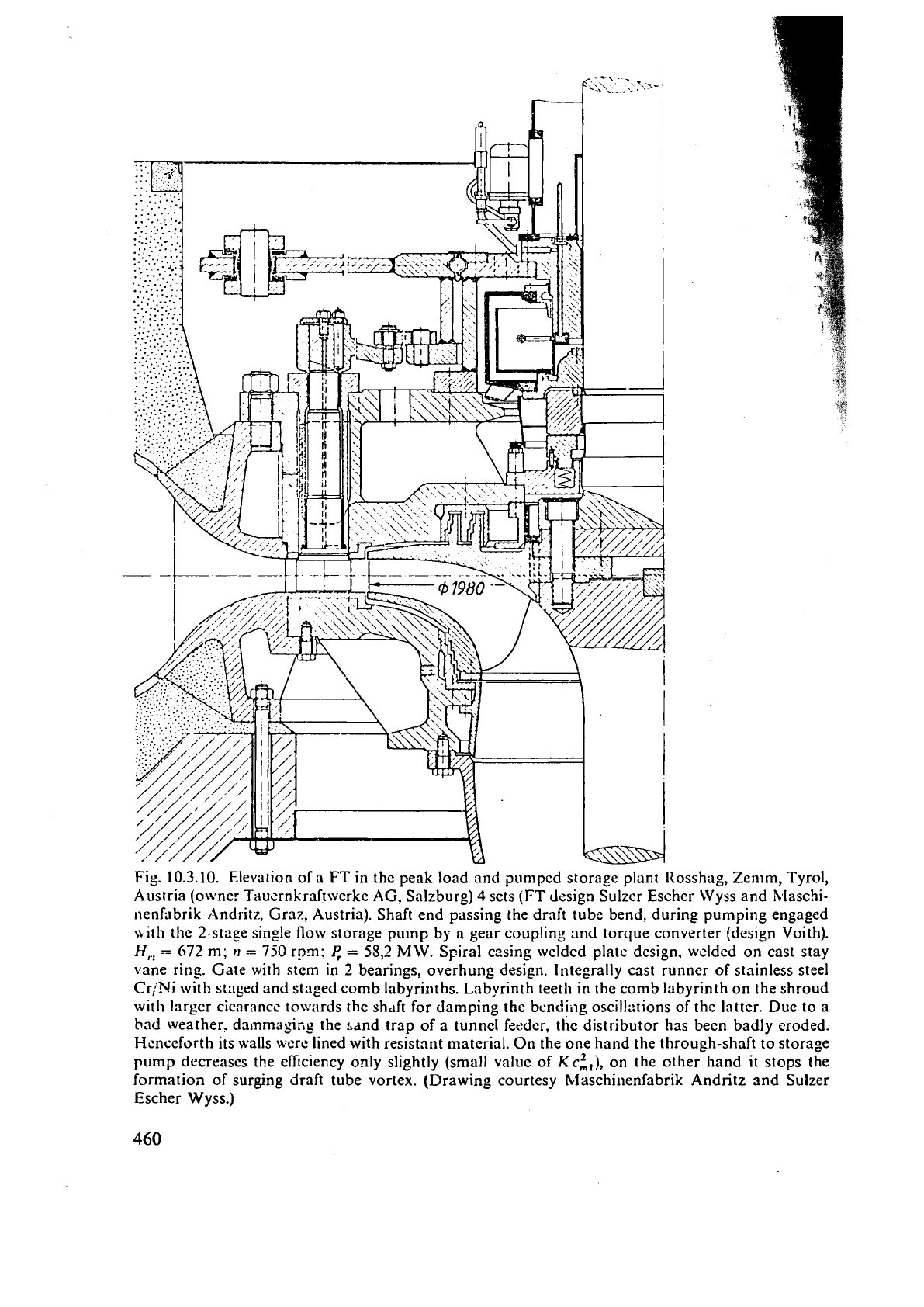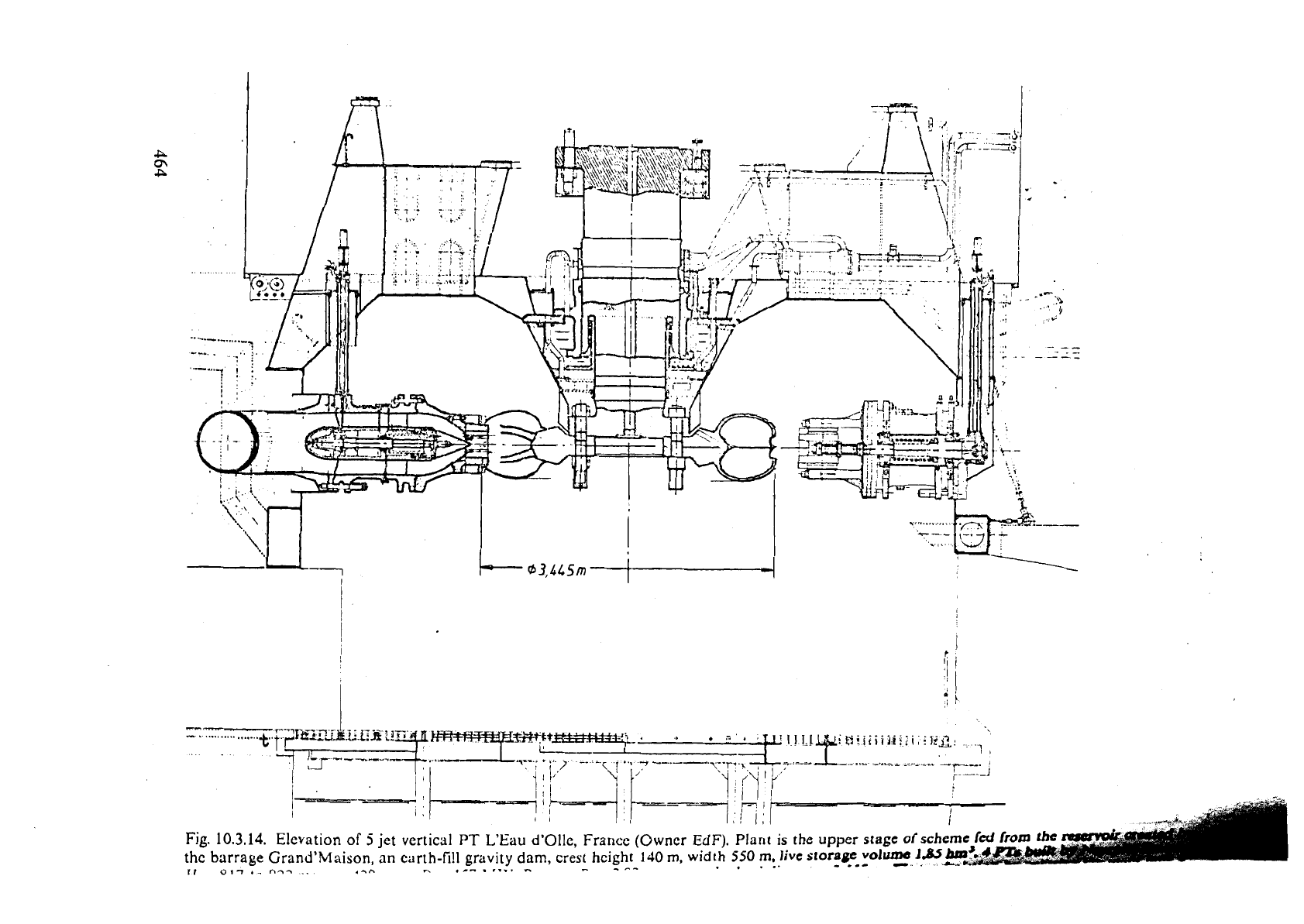Raabe J. Hydro power - the design, use, and function of hydromechanical, hydraulic, and electrical еquipment
Подождите немного. Документ загружается.


Fig. 10.3.7. b) Sectional drawing of vertical shaft
FT
at Guri, 2nd polvcr house, Rio Carorli.
\lcnczuela (owner
Corporation
Vcnezolana dc Guayana, Republic of \lcnc~~~cla) built by
Hit;~s;hi
Ltd, Japan.
H
=
11
l
to 146
m,
P
=
476 to 730 MW continuous, temporary output
767
Mi\'.
n
=
112,5 rpm. After previous designs, commissioncd bctwccn 1968 and
1977
\vith outpt~ts
of
P
=
218 to 400
M
W
at heads of
H
=
11
5
m to 136
m,
thesc 10 units. commisioned
198
1
arc at
present the
most potverful
FTs
built in Japan. Simplified design \vith par:tllc.l p1;1ic spiral c;ising.
conical hub, slag-welded shaft. The runner is a onc-piece casting of 13
%
Cr
-
1
"/o
Ni stainless stes!.
Iodate the largcst of this kind in the \vorld of 7,17 n1 outermost diametcr, and a tveight of
130
tonr.
For these machines the hcad of the Guri plant has becn increascd from
11
1
m
to
146
m
by increasing
the crest height of the concretc gravity dam. The submergence equals that of the prcvious design,.
According to the author's in~pression on sitc, the 400 MW FTs showed bad cavitation pitting after
one
ycar of full load operation under the smaller hcad of
11
I
m. (Drawing courtesy Hitachi, Ltd.
Japan.)
Fig.
10.3.7. a) Sectional drawing of vertical shaft FT at Hbrspranget, 1,ulc river: Swedcn (owncr
Swedish state power board) 4th unit built
by
KaMeWa
AB,
Kristineham, Stvcdcn.
H
=
103
m.
P
=
182,8
MW,
n
=
166,7
rpm. Runner throat diameter Dl
=
4,235 m. For I~ighest reliability the
stay vanes were inscrtcd into corresponding holcs
of
the stay rlng weldcd from steel plater. ant1 tlrcr!
connected with thc wetted face of the stay ring on both sides by means of a corner \veld. When
commissioncd in 1952 thc
average
annual prodxtion of 2020 GWh of Hirsprangct made a contri-
bution of
more than
2G%
o: Sweden's electricity production. With an extension in
1974
to
SO
the
Production of Hirsprangct ;:.as raised to 2240 GWh and the installed capacity to
935
hIW.
Thc
lasi
and
5th
unit then installed by KaMcWa
had
an output of
P
=
450
bIW
(n
=
83.3 rpm) with an axial
tons, and was since that time the most
powcrful hydro turbine in Europe. The water
s usual in Sweden) of a vertical penstock to the underground power station
and
a
very
1
tailrace
tunnel with an upstream gate. A 400
kV
AC
transnlission linc
with
a Icngth
first of its kind in the world was built in 1952 from Hirsprangct to central Swedcn.
locatio~l (north of thc Arctic Circle) and the need
fo;
expcrienccd and skilled
town with the ncccssary social
scrvices had
13
be built at sitc. Thc town
m"sistcd of houses for 1200 employees and their families in all 2200 people. as well as shops,
bs~itnls, post
and
police station, other social services such as sport and leisurc htcilitics and church.
'Dr
wing courtesy KaMcWa
AB,
Kristincham, Sweden.)
p

Fig. 10.3.8. Elcv:~tion
of
tl;c
IT
1tap;iric;l. rio Siio I~rnnciscc, 13rnzil lowncr Colnpanhia tIidroe1C.c.
[ricn tlo
Siio
Franciscc.)
In
sets (design I-l).dronrt. hliian).
11,
=
53,2
m;
ti
=
Y
1.8 rpnl;
P,
=
264
MW.
Spirai casing p:~ral!cl pliltc
rype
ol'stccl plates \veldcd
on
site, inlet cliutncter
'1.5
ni. Kunncr made
up
by
ncldin!; \vith ccp;i::l!c c:~rbo!l stccl b!arlus,
7.925
ni ili;~rnetcr, weight
IS@
tolls. Thrnst bearing:
1600 tons load.
\.ia tr~~ricated cone on [lie licad cover, with high prcssurc oil i~~jcction. (Drawing
courtcyy CIydroart. \,lilan, Italy.)
the ranner
vanc
channels. especially the inlet edge of the runner vaces. In a
PT
such
dal-rlage
is
restricted
tc
the mouth of the nozzle, the point of the niedle and the cutting
edsz
anti
the jet crltout of the bucket. As these mcrnbers are much easier to get at any
revision is
~nuch casier in a PT.
Thc dismantlins
and
cxchi~nge of
a
PT's wheel need much less time than that of a
FT
runner. Also thc repairs of
a
PT,
e.g.,
the wclding and the buildirig up welding and
grindi!~g
of
a bucket of
~1
PT
is m~lch easier to carry out and to check tllari the correspond-
ing repair on a FT runner.
d)
I11
the case of very small output the application of a
FT
would lead to rotational speeds
above the upper limit of
a
two-pole alternator. The reciuction gear then needed would
raise the price of
a
FT
set, whence
a
PT
with its red~iced speed is preferably employed.
Sorile
S~IC~L
ill1
I.CUI(~I-~S
~*oi~c~c~rniit,q
Peltnil
rlrl-bines:
The
Peltori turbine. not especially treated here, is usually considered a safe machine. But
it
certainly has some problems. One problem, namely sand erosion occurs mainly on
needle and nozzle
anti can be attributed to the high velocities there. It increases roughly
with the
2nd to 3rd power of the head, and with the occurrence of hard ingredients
in
the
water such as quartz.
In some cases sand erosion cannot
bc
eliminated even by means of sand separators
at
the

fig.
l().3.T
I'rojcct
of
n
high
hcatj
l,.r;l~~cis pt~~nl>-turl,il~c
1000
rn.
Xl;~chinc in
I31
.-
I
tank:
cylindric;ll
pier
From
11:
dlric,
or
ul.:
Single-
2nd multi-st:lge
pump-turhines for high
head
storagc plants. Paper
,4~31E
Pump turbinc
$hcmcs.
171uids E~ginecring
conf.,
Niagara Falls,
New
I'ork
1979.
110.1
533
(Draw-
,
courtesy Sulzcr
Escher
mc
\\'J'~~.)
~ntrtke. In this casc the sand particles are so small as to be kept suspended by Brownian
motion of the
surrcunding liquid
e.g.,
glaciated rock.
Another
problcm
is
the erosion by
a
droplet impact. It corresponds essentially to that
by
avitation. Moreover droplcts increase disk friction, when they impinge on the wheel with
r
slip
in
the tangential direction
(Cap.
5.5).
An
erosive droplct impact prcferably occurs on the back of the buckets, close to the cut
oul.
This originates from the wheel's overtaking slow droplets. Such detrimental droplets
rcsult
from
:
I)
slow fluid particles at the outer edge of the jet, especially when the bucket cut out
is
100
narrowly spaced,
3
droplets that are discharged from neighbouring buckets in the case of more than one
it,
1)
droplets that are reflccted from a casing
wall
too near to the wheel.
0
droplcts reflected from a tailwater surface which is not sufficielltly away from the
bottom
of the wheel.
the laiter factors increase their detrimental influence decisively with the flow rate and
@mewhat
wvjth the hcad, but also when the bucket's cut out edges are too close to the
of
the jlet.
e free height of
a
Pclton wheel and the spacing of its casing should
be
the number of jets, and with the jet to wheel diameter ratio.
kuse dthe two bcnds in series and in different planes, upstream of the nozzle within
hmain'of a
PT
with vertical shaft, the formation of a streamwise vorticity in the main
459

Fig. 10.3.10. Elevation of a FT in thc peak load and pumped storage plant Kosshag, Zemm, Tyrol,
Austria (owner
Taucrnkraftwerke
AG,
Salzburg)
4
scts (FT design Sulzcr Escher Wyss and hlaschi-
nenLlbrik lindritr, Graz, Austria). Shaft end passing the draft tube bend, during pumping engaged
\\.it11 the 2-stage single
flow
storage pump
by
a gear coupling and torque converter (design Voith).
H,.,
-
672 m;
r=
750 rpm:
1:
=
55,2
MW.
Spiral czsing welded plate design, welded on cast stay
vane
ring. Gate with stem in
2
bearings, overhung design. Integrally cast runner of stainless steel
CrjNi with staged and staged comb labyrinths. Labyrinth teeth in the comb labyrinth on the shroud
with larger
cienrance towards thc shdft for damping the bendilig oscillations of thc latter. Due to a
bad weather.
da~nmaging the sand trap of
a
tunnel feeder, the distributor has been badly eroded.
Henceforth
its walls were lined with resistant material. On the one hand the through-shaft to storage
pump decreases the efficiency only slightly (small value of
Kc:,),
on the other hand it stops the
formatioa of surging draft tube vortex. (Drawing courtesy hlaschinenfabrik Andritz and Sulzer
Escher Wyss.)

-
-"rZruF.-T-d
?y
--
yx-vc=
.
*./zY=--
'-.
-33-
>'
/
'
-2'
92
O
<..
=,Y
-*
1
,s,
I
+
-'a;-
:3
,'
,,>,.
.'<-
.
,.,;
4;
-,
//,/J
.,-
*;
.
.;y
,>
=@..
'-\
i
,
',','*
f
'
..a,
%.
*>
3
*-.-y-
-,
,
*-,\
1
I
>
,t
%
-
1
"-
.-
3
<,,
3
.
%
':
1):
-
"
rX
..
?
-
;
-.
'?
rt'
,
i
;
'+,--
.
>
-1
\
-\_
?
!
I
i
I
I,
-
*
-I
1
i
I,
.
-
p
'
i
1
...
'I
.
..,
1'
.
'-
..
i
2.
A.
>
#.
,
.
i
i;
I
-t
'.,
-a.
.
-
.--
.
\
%'
i
*.''%.
--;-.
-
-
'
-.
-*
L.
_
i
--*a*---
,
-
.
.
.z~---~
-
#.
-
-'
Fig.
10.3.1
1.
Model runner of the
FT
at tliiuslinp, Ziller, Tyrol, Austria (o\vner Taucrnkraftwerke
AG,
Sallburg)
2
sets peak load and pumped storage plant, FTs built
by
Sulzer Escher Wyss,
Switzerland. Data of prototype:
H
=
620 to
744
m;
n
=
600 rpm;
P
=
180
MW.
Runner:
D
=
2,767
rn.
To
date the
FT
\+ith the highest hcad in the world.
,I
.
H
-
P
amounts only
PO0/0
of
that
d
Wehr (Fig.
10.3.12),
but is
380%
that of Rosshag.
The
product
n
-
H
.
P
of Wehr is 160% that of
Grand
Coulee Ill, and 330% that of Churchill Falls. Scroll casing of rolled steel plates with high
Ykld point, spot-welded on integrally cast 10-vane stay ring of stainless stcel. Pseudo parallel plate
design
as
in Fig. 1.6.4
b.
(Photograpti courtesy Sulzer Escher Wyss arid Andritz.)
flow
of the nozzle is favoured (Cap.
7.2).
Thereby the acceleration of flow in the nozzle
Urains the streamwise vortex filaments. This increases the kinetic energy of the latter, lost
for
shaft
work.
Thereforc eflorts should
be
made in the design to ~ninimizc this effect by
avoiding too strong a curvature of the main in planes inclined to each other and by
aequate flow admission (Cap.
3.4).
he
above mentioned loss in the nozzle of an impulse turbine seems to be the reason for
a
negative scalc effect in the overload range (Cap.
5.5).
Hence
a
prototype's efficiency
YY
drop below that of the model, but curiously usually only at overload.
me
Cross
flow
on the bucket (Cap.
5.5)
as mother source of this loss behsviour should

Fig.
10.3.12. Horizonial high head
FT
of thc ternzry pumpcd storagc plant Wchr, Wehra, West
Gcrmnny (owncr Scliluclissc
AG,
Freiburg).
4
sets with FTs built by Sulzer Esclicr Wyss and
4
2-?!age
tlouble flo..v storage pumps with torclue converters built by Voith (see Fig. 1.6.4
a).
Horizon-
tal
shalt, dctachablc during pi~niping by means of an overriding clutch.
FT
for
H,,
=
645
m;
rr
=
6OU
rpm;
=
257.5
XIW.
Runner:
D
=
2,685
m. To date the FT with tlic largest
H
.
n
.
P.
/llt~rn:i~o: with air-cooled rotor and water-coolcd stator. Initial troubles with stator laminations
hcattxl too ~nucli. ;~nd 11;11rlj1ic cracks in the stay vanc'part hint at
3
limiting hydro-clcctric design
in 1972. Thc v;~ryin= span of the stay vanes rcquircs a carefill strcss calcuiation also with respect to
frlrig~~e cffcct. sce
Greiir
[10.127]. Bccausc of the high vclocitics, wcar of wctted parts cncountcred
by
c;3rcl'ul niatcrial selcction. Runner
1
and rotary labyrinth rings: integrally cast of Cr/Ni 1314 steel.
Stationary
eschanpnble lining around runner in rcgions
01
high velocity: cast of Cr/Ni 1311 bteel.
Components in the regions of lower velocity: Cast iron, Ni, Mo-alloyed. Gate vanes: Forged Cr/Ni
13/4 stcel:
protective
laycr on thc gate vane channel wall of<:r/Ni by built up welding. Spiral casing8
linc gr;~in stcel, welded from platcs
of
3600 bar yicld point. Stay ring: CrjNi
171.1
cast steel; stay vane
surlilce: metal spray layer of Ni-AI-13 Cr steel. Through shaft
2
lined with hard chromium layer,
ncccssriry to decouplc turbine duricg punlping by means of a special self shifting synchronizing
ovcrriding clutch, type
SSS.
Because of the pump, minimum subrnergcnce about 70 m. Tailrace
tunncl
1.5
km
long with 2-chamber surge tank. Maximu~n working pressure-90 bar. Fly-whecl
mo:ncnt so that start up time
T,
=
7,8
s. Rclativc overspeed after load rejection 50%. Fron special
ixsue. Scliluchsecwerk
3,4
bearings,
5
covers,
6
gate,
7
gate ring,
9
draft tube,
10
sh:~ft seal,
11
clutch
adjustmcnt. (Drawing courtesy
Sulzer Eschcr Wyss, Switzer.land.)
be
kept
in
limits.
Therefore the initial curvature of the bucket cross section close to the
inlet
edge should
be
as small as
possible.
In a limiting design, in consequence of stress concentration and wear near the cutting edge of a
bucket, the unit outplit per bucket can be increased only by blunting the edge at the cost of efficiency.
.Modern trends in the design of PTs are given in
(10.621.
Recent designs
arc
shown
in
the
Figs. 10.3.13 to
15.

Fig. 10.3.13. a) Wheel pit of the Pelton turbines of Sy Sima plant. Norway.
5
nozzle vertical
PT
in
operation since spring 195
1
and since that time the world's most powerful Pelton turbine.
H
=
885
In:
rt
=
3110 rprn;
P,
=
315 MW;
e,
=
350
MW,
built by Kvaerner I3rugg
A/S,
Oslo.
Nor\vay. b) From thc same manufacturcl-,
2
Pelton turbines
of
thc
Lang
Sima plant under erection,
in
operation since 1980. They are vertical 5-nozzle units with
I],,
=
1
151
m;
rl
-
428
rpm;
W
(rated value
H,
=
1006
m.
=
260
MW).
In
this plant, at highest head the
11
.
If
.
P
of Sy Sima
plant,
and
175%)
that
of
Wehr. Note thc bridge
of
jct
deflector, bucket
cut-out, Vuckct
edge,
and stiffening ribs on the back of bucket. (Photograph courtcsy Kwaernc-r
Brugg
S/+,
Oslo, Norway.)

Fig.
10.3.14.
Elevation
of
5
jet vertical
PT
L'Eau
d'Olle, France (Owner
EdF).
Plant
is
the
upper
stage
o
the barrage Grand'Maison,
an
earth-fill gravity
dam,
crest
height
140
m.
width
550
m.
live
stora~
vole
1
a--.....
-
-
- --
.
.
.
.-
-
..I-
rr
O~T
+
n??
4-A

Fig.
10.3.1 5. a) Cross section through one of the
5
horizontal shaft sets with ?-wheel. 2-nozzle
PT
,I
prutz, Knunertnl, Austria (o\vner Tiroler Wasserkraftwerkc, Innsbruck) built by
J.
XI.
I*i)it/i.
H
=
890 m, n
=
500 rpm,
P
=
7S,8
MW.
Sm;ill dcflcction ariglc of y-fitting and small curv:iturc of
the
pipe at the ends of the y-bra~iches diminish disturbances of uniformity in thc flow admission to
~hc
nozzles (so called "tongs design"). Whccl of intcgr;~lly cast stair~less stcel,
D
=
2,31
m,
nccctlc
servo motor in the nozzle pipe with fcedback linkage of both the nozzles joined together. Ivhich givss
acertain position of the jet deflector via a carn to a given ncedle position. Both
jet
deflectors operated
\:ia linkage by
a
common servo nio!or. Smnll brake nozzlc between the
2
main noz~les. jet splittcr
on
the
top of lo\icr nozzle to minimizc jet disturbnncc from the other jct. C.ising cquippcd I\-ith guicic
plates to deflcct jct towards the tailwatcr in the case of runaway. Occasi~nally Dndly snndcroded by
fatigue-conditior~cd failure of the surgc tank lining. (Drawing courtcsy
J.
I!!.
I'birh.)
-
-.
.
.
-
--
-
-
-
..
-
-
--
-
-
--
.
.
.
.
Fig. 10.3.1 5.
b)
Cross section of I-wheel, I-jet horizontnl shaft
PT
Salanfe Mii\.illc. S\vitzerlai;d built
by
Vcvey-Charniilles
Engineering
Works, Switzcrlnnd. Straight admission pipe, necdlc scrvoniotor
in the nozz e pipe, jet prcsser, brake no7.zlc. Because of thc high l~ead, sm;lll jct tvhccl diametcr ratio.
H
=
1447
,
rr
=
500
rpm,
P
=
35,2
MW.
This is the 3 rd higl~cst hcnd of the tvorlri iisecl
by
tr
PT.
i
PTs
ith the highest !,cads in the world, n;llncly Chandolinc. Grancie Discncc. Switzcrlanti
(H
=
1710
/n,
I'
=
36.6
M
W)
and Reisscck, Austria
(ti
=
1765 m.
P
=
22,8
h,W)
arc also
of
the
I
I
nobzlc type and wcrc built also by Vcvcy Charniillcs Enginwring \+'orks. S\vitzcrland.
(Dri1wing cdllrtcsy Vcvcy Charmillcs Engineering Works.)

10.3..3.
'l'lle
litnits
of
a
F7'
in
the
lower
Ilcad
range
Accorrling to the expcricncc of Sul~cr 1scllt.r Wyss, tI1c1-c exists also
a
Lone
of over]
%%&
OP
;;1
with thc K;lpl;ln tt~rbinc
(KT).
This r:lni.,e has npprorini:ltsly :tn llppr limit
:lt
a
head
of
ahout 70
rn.
Son~e
KT
l)l:~nts
with
:111
upper he;ld limi! :~bovc this figlire are usually
locatcd
at
tile
base of a dani storing their tailwatcr and
needing
no
esscnti:~l
excavation
'
3
for su bniergence.
f
In th'e range of low flows between
1.5
and
2.2
m3/s
up to
n
Itcad of 23
in,
the upper head
*
limit
IE(m)
of this zone rcads (Fig 10.3.16):
111
H
=
1.33
t
2.42
111
Q,
Q
in rn3/s. In the head
:
'-34
range between
23
m
to 67
m
and the flow range between
2,2
m3/s to 13 mJ/s this litnit is
%
given by:
Irl
H
=
2,55
+
0,672
In
Q.
b
2
In the head rarlge below
70
m
and
a
flow above 27 m3/s thc limit between
FT
and
KT
"
follows from
In
H
=
0,665
In
Q.
These formulas reflect only the actual state of the art. This changes
in
coilrse
of
time
so
-
as to raise the output and head limit for a
KT
in
thc
fiiturc. This holds especially for lower
flows between 13 to 350
rn3/s.
Tile
causes for this evolution may be traced to the following
reasons:
First the low-head
FT
with hig1:est specific speed has
a
strongly hook-forrnecl
q
(P)
graph
'
OWs
1
2
5
10
20
50
100 200
500.
1000
Fig.
10.3.16.
Range of applicdtion for
the
various hydro turbomachines on
a
Q(H)-graph according
to
Sulzer Escher Wyss.
